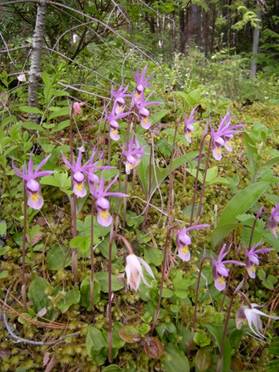Oh yea – there’s this whole other Kingdom of plants! Kingdom, Phylum, Class, Order, Family, Genus, Species – or easier to remember as Kings Prefer Cokes Over Frosty Grape Sodas.
I know this one as fairy slipper, with reference to the shoe like appearance of the lower lip of the flower. It has a wide distribution across the northern US and southern Canada. The Pacific or Western Fairy Slipper range extends from Idaho, south to northern California, and up to southern Alaska. It prefers shady locations beneath evergreens with a moist/rich organic soil. Though it has a wide range it appears to have a more discreet local occurrence because of its growth requirements. It blooms from spring to mid-summer from a small tuber. The flower is only an inch across but is a wonderful magenta color with a vanilla scent.
They are not considered a rare plant, but have some pretty specific requirements and grow in partnership with a soil fungus that shares nutrients taken from tree roots. It has a single leaf for photosynthesis so it needs some help from the nutrients provided by the fungus. So if you try and dig it up and take it home it will die. Of course, this doesn’t seem to stop folks who apparently aren’t aware.
Calypso, the sea nymph, was the beautiful daughter of the Titan, Atlas. In the Odyssey, Calypso used her beauty to keep the shipwrecked Ulysses captive for seven years on her island of Ogygia. This plant also is referred to as “Hider-of-the-North” due to its limited occurrence. Calypso, the sea nymph was also called “she that conceals” or “the concealer”. The Greek work Calypso means covered or hidden from view. A rather apt name.
This photo was taken in the NE corner of WA adjacent to the Pend Oreille River, just below the US/Canada border. This was a project for the relicensing of the Seattle City Light Boundary Hydroelectric Project – a survey of lands surrounding river and reservoir. Not much data were available prior to the rare plant surveys – well, because there was no reason to look previously I guess. The survey results found some relatively large occurrences of a number of rare plants – so many of one species that it was down-graded in rarity status by the State of WA.
It’s a common occurrence for rare plants – most of the occurrences are near easily accessible areas. One USFS botanist I know said “It’s amazing how those rare plants are clustered around trail segments”.
